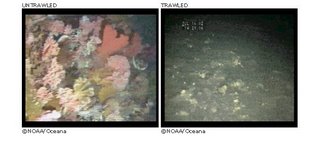Effects of Bottom Trawling on Deep-sea Ecosystems

Deep beneath the surface of our oceans, ancient forests of cold water corals, soft seapens, sponges and seawhips are in danger of destruction from a commercial fishing technique called bottom trawling. Throughout these ancient forest live more mobile animals such as sea spiders—lobster-like crustaceans live in sheltered crevices. In the softer sediments, a dynamic community of small worms and crustaceans exists. In the waters around the seamounts live large populations of fish, swimming in the constant currents. Many seamount-dwelling species are not found anywhere else, and it is believed that some are confined to only one or two individual seamounts!
Biologists have estimated that between 500,000 and 5,000,000 marine species have yet to be discovered, some dating back to prehistoric times. But these very species are in serious danger from the world's most destructive fishing practices. This is truly the last undiscovered wilderness left on the planet and they must be protected.
Seamounts are uniquely biodiverse mountains and mountain ranges that inhabit the topography of the ocean floor. They rise at least 1,000 metres above the surrounding seafloor. It has been estimated that there are tens of thousands of seamounts across the world's oceans: upwards of 800 in the Atlantic Ocean, with more than 30,000 believed to be in the Pacific Ocean. Amazingly, the Earth's longest mountain range is not on land but under the sea - the Mid-Oceanic Ridge, which winds around the globe from the Arctic Ocean to the Atlantic. It is four times longer than the Andes, Rockies, and Himalayas combined!These seamounts are hard surfaces that are colonised by colorful forests of attached cold water corals, soft seapens, sponges and seawhips.
The number one threat to this uniquely biodiverse area of Earth is bottom trawling and unfortunately, the commercial fishing industry has gotten to know about the rich pickings that exist in these deep waters. The industry has developed its boats and scaled up its trawl gear to enable it to extend its unsustainable fishing practices into previously unexploited deep waters and seamounts. Bottom trawling involves dragging huge, heavy nets along the sea floor. Large metal plates and rubber wheels attached to these nets move along the bottom and crush nearly everything in their path. All evidence indicates that deep water lifeforms are very slow to recover from such damage, taking decades to hundreds of years—if they recover at all.
Greenpeace International is campaigning for an immediate halt to high seas bottom trawling. If allowed to continue, the bottom trawlers of the high seas will destroy deep sea species, before we have even discovered much of what is out there. Think of it as driving a huge bulldozer through a lush and richly populated forest and being left with a flat, featureless desert. Think of it as beef farming by dragging a net across entire fields, cities and forests to catch a few cows. It's like blowing up Mars before we get there.
Incredibly, there are more maps of the moon than of the Earth's sea bed, and it has only really been over the last 30 years that we have got to know about the rich and complex world of the deep ocean. We have been fascinated by the discovery of water on Mars and its potential for life - but there is underwater life right here that could disappear before we even explore it.
If you would like to more about the destruction—and read sientific proof—done by bottom trawling, then check out and download (pdf) the Deep Sea Coalition’s “Bottom Trawling: RED HERRINGS”
The Deep Sea Conservation Coalition (DSCC), a combined force of more than 40 conservation groups from around the world, is calling on the United Nations General Assembly to secure a moratorium on high-seas bottom trawling until a regime to protect deep-sea fisheries and biodiversity is developed and implemented. In an effort to fight this conservation measure, the fishing industry has made numerous fictitious claims aimed at downplaying the detrimental effects of bottom trawling on deep-sea ecosystems. These claims are easily refuted by the staggering amount of scientific evidence demonstrating the harmful impacts and unfortunate expansion of the bottom-trawling fishery from the shallow continental shelf to deeper and more distant waters beyond national jurisdiction. This document presents a compilation of the claims offered by the fishing industry, each followed by a powerful rebuttal based on the best available science.


0 Comments:
Post a Comment
<< Home